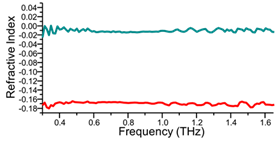Research Topics
- Memristor
- ZnO
- THz
- Quantum Cascade Laser
- High Electron Mobility Transistors (HEMTs)
- Heterojunction Bipolar Transistors (HBTs)
- Resonant Tunneling Devices
- Transport in Semiconductors
- Noise in Semiconductor Devices
- THz Assisted Counterfeit Detection
- Engineered Nanostructures for Authentication
- Solar Blind Detector
- Photonics
- Si & Related Devices
- Fundamental Physics
THz Assisted Counterfeit Detection
Detection of packaged counterfeit electronics using THz spectroscopy is introduced by the research group led by Dr. Anwar. The process does not require any “golden IC” for authentication and the IC need not be powered up.
The Back Referenced THz Imaging for Counterfeit Detection, takes Five spot measurements both on the front and back sides of the packaged IC. This results in the typical THz spectroscopy pattern showing reflections from the surface and from the package-IC interface. The extracted refractive indices of the  front surface w.r.t. the back surface or the back-referenced refractive index, ∆n, is extremely sensitive to any difference between the two surface in terms of (a) material properties – presence of any foreign material and (b) thicknesses of the front and back surfaces from the IC-interfaces.
front surface w.r.t. the back surface or the back-referenced refractive index, ∆n, is extremely sensitive to any difference between the two surface in terms of (a) material properties – presence of any foreign material and (b) thicknesses of the front and back surfaces from the IC-interfaces.

With the front and back surfaces going through the same package processing steps and with the die located equidistant from the surfaces should result in a vanishing ∆n, something that we observe in the top trace allowing us to conclude that the inspected package is authentic. Similar measurement on a counterfeit IC package results in the red trace with non-zero ∆n.
The back-referenced refractive indices of the front surface provides a unique, fast and reliable mechanism for the identification of counterfeit ICs. Note, THz absorption characteristics do not contain any unique signatures allowing differentiation between authentic and counterfeit electronics. It is anticipated that a hand-held THz source programmed to extract ∆n will allow a quick determination of counterfeit electronic parts.
Additionally, the use of advanced imaging techniques have allowed us enhance the resolution of THz imaging providing a non-destructive means to investigate packaged ICs.
Publications:
- Modeling of terahertz images based on x-ray images: a novel approach for verification of terahertz images and identification of objects with fine details beyond terahertz …
K Ahi, M AnwarTerahertz Physics, Devices, and Systems X: Advanced Applications in Industry …
- Developing terahertz imaging equation and enhancement of the resolution of terahertz images using deconvolution
K Ahi, M AnwarTerahertz Physics, Devices, and Systems X: Advanced Applications in Industry …
- Advanced terahertz techniques for quality control and counterfeit detection
K Ahi, M AnwarTerahertz Physics, Devices, and Systems X: Advanced Applications in Industry …
- Terahertz Techniques: Novel Non-destructive Tests for Detection of Counterfeit Electronic Components
K Ahi, M AnwarConnect. Symp. Microelectron. Optoelectron
- A novel mathematical approach for converting X-Ray images to terahertz images
K Ahi, M AnwarConnect. Symp. Microelectron. Optoelectron.
- Terahertz Physics, Devices, and Systems X: Advanced Applications in Industry and Defense
MF Anwar, TW Crowe, T ManzurProc. of SPIE Vol 9856, 985601-1
- Terahertz characterization of electronic components and comparison of terahertz imaging with x-ray imaging techniques
K Ahi, N Asadizanjani, S Shahbazmohamadi, M Tehranipoor, M AnwarTerahertz Physics, Devices, and Systems IX: Advanced Applications in …
- Authentication of electronic components by time domain THz Techniques
K Ahi, N Asadizanjani, M Tehranipoor, AFM AnwarConnect. Symp. Microelectron. Optoelectron., Bridgeport, Connecticut, USA
- THZ Techniques: A Promising Platform for Authentication of Electronic Components
K Ahi, N Asadizanjani, S Shahbazmohamadi, M Tehranipoor, M AnwarCHASE Conf. Trust. Syst. Supply Chain Assur., Storrs, Connecticut, USA
- Terahertz Physics, Devices, and Systems IX: Advanced Applications in Industry and Defense
MF Anwar, TW Crowe, T ManzurProc. of SPIE Vol 9483, 948301-1
- A novel approach for enhancement of the resolution of terahertz measurements for quality control and counterfeit detection
K Ahi, M AnwarDiminishing Manufacturing Sources and Material Shortages (DMSMS)
- Terahertz Physics, Devices, and Systems VIII: Advanced Applications in Industry and Defense
M Anwar, TW Crowe, T ManzurProc. of SPIE Vol 9102, 910201-1
- Terahertz Physics, Devices, and Systems VII: Advanced Applications in Industry and Defense
MF Anwar, TW Crowe, T ManzurProc. of SPIE Vol 8716, 871601-1
- Terahertz Physics, Devices, and Systems VI: Advanced Applications in Industry and Defense
AFM Anwar, NK Dhar, TW CroweProc. of SPIE Vol 8363, 836301-1